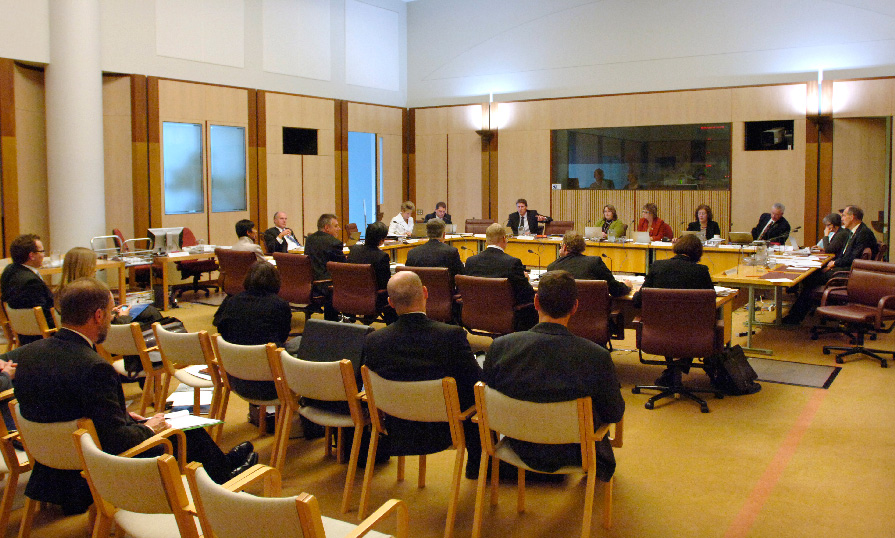Committees
Parliamentary committees investigate issues and proposed laws in detail. This fact sheet explains the role of committees, how they work and the types of committees in the Australian Parliament.
What will I learn?
- Committees investigate issues and bills in detail.
- People can make submissions to committees and give evidence at committee hearings.
- Committees help members of parliament be informed before making decisions.
Curriculum alignment
Year 6 ACHASSK146
Year 8 ACHCK062
Year 9 ACHCK103
What is a committee?
A parliamentary committee is a group of members of parliament who have been asked by the Senate or House of Representatives to investigate issues and bills – proposed laws – in detail. Committees hold meetings called hearings in Parliament House and around Australia. They invite Australians to provide information about the issues they are investigating. Committees closely examine – scrutinise – the actions of the Government.
Purpose of committees
Parliamentary committees closely examine issues and bills. Committees are an important part of the work of Parliament because they:
- provide more time for senators and members of the House of Representatives to investigate bills and policies. There is not always time to debate complex issues in detail in the Senate and House. A committee may have weeks or months to closely examine an issue so members of parliament are informed before making decisions.
- inform the Parliament of a range of views from the Australian community. Individuals and groups are invited to send submissions – opinions and proposals – to committees. Committees often hear from experts, interest groups, government departments, community organisations and other interested members of the public.
- keep a check on the activities of the government. In Senate estimates, committees examine how the government plans to spend public money. They can order ministers and senior public servants to speak at hearings to explain their decisions.
How committees work
A parliamentary committee in action at Australian Parliament House.

DPS Auspic
Description
This photo shows a group of people sitting at desks set up in a large rectangle. The people at desks each have a microphone and a stack of papers. There are people sitting in 2 rows of chairs set to the side of the rectangle of desks. These people appear to be watching what is happening at the desks.
Copyright information
Permission should be sought from DPS AUSPIC for third-party or commercial uses of this image. To contact DPS AUSPIC email: auspic@aph.gov.au or phone: 02 6277 3342.
A parliamentary committee in action at Australian Parliament House.

DPS Auspic
Description
This photo shows a group of people sitting at desks set up in a large rectangle. The people at desks each have a microphone and a stack of papers. There are people sitting in 2 rows of chairs set to the side of the rectangle of desks. These people appear to be watching what is happening at the desks.
Copyright information
Permission should be sought from DPS AUSPIC for third-party or commercial uses of this image. To contact DPS AUSPIC email: auspic@aph.gov.au or phone: 02 6277 3342.
When the Senate or House sets up a committee, it decides what it will investigate and who the members of the committee will be.
Most members of parliament, except ministers, serve on committees. They are usually made up of 6 to 10 members of parliament and have a mix of government and non-government members. Committees may be made up of only senators or members of the House, or may be joint committees which include senators and members of the House.
The committee invites submissions from the community. After they read the submissions, they invite people or groups to appear at hearings to provide more information or answer questions from committee members. They can order people to appear at a hearing and to provide documents.
After the hearings are finished, the committee writes a report which is presented to Parliament. The report will include what the committee has found and may make recommendations to the Parliament. Members of parliament might use the report to help them decide how they will vote on a bill or to develop bills or amendments – changes to bills.
Types of committees
There are different types of committees:
- Standing committees examine bills and issues relating to particular subjects. For example, the House of Representatives Standing Committee on Employment, Education and Training examines bills and issues relating to these areas.
- Select committees examine specific issues for a limited time. After a report is presented to Parliament, the committee ends. For example, the Senate Select Committee into the Obesity Epidemic in Australia inquired into the impact on health care from the rise in obesity in Australia. After giving their final report to the Senate, the committee was closed.
- Estimates committees usually meet 3 times a year to examine how the government plans to collect and spend money – the Budget. The only people who appear before an estimates committee are ministers and senior public servants.